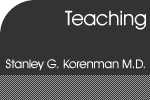

|
<< Previous Section | < Previous Page | Next Page > | Next Section >>
Bibliogrphy (page 3 of 10) Chen, D. and B. Worrall (2006). "Practice-based clinical research and ethical decision making--Part I: deciding whether to incorporate practice-based research into your clinical practice." Semin Neurol 26(1): 131-39. This paper reviews for neurologist practitioners what clinical research is and the pros and cons of incorporating research into their practices. It also points out, with the expansion of clinical research, that they might have to advise their patients about research participation even if they don't do research themselves. http://www.thieme-connect.com/DOI/DOI?10.1055/s-2006-933317 Chen, D. and B. Worrall (2006). "Practice-based clinical research and ethical decision making--Part II: deciding whether to host a particular research study in your practice." Semin Neurol 26(1): 140-7. The second component of the previous article. Cohen, J. (1995). "Share and Share Alike Isn't Always the Rule in Science." Science 268(5218): 1715-8. This is a component of a series of articles on sharing in science, generally asking whether the hallowed principle of collegiality has lost its force and left us in a dog-eat-dog scientific world. Cohen, J. (1995). "The culture of credit." Science 268(5218): 1706-11. Scientific ideals call for collaboration and sharing. But in today's competitive scientific enterprise, a tremendous premium is placed on individual credit, setting the stage for conflict. Cottingham, K. (2001). "University-Industry Collaborations: Whose Data?" Science 11(27). This ethics case discussion relates to a PhD candidate who participated in a clinical trial as part of her research and found that she could not publish the data as part of her thesis. Because the results were not favorable, she was forbidden to use the data. Three "experts" discussed the scenario. Cournand, A. (1977). "The Code of the Scientist and Its Relationship to Ethics." Science 198(4318): 699-705. Scientist's norms (principally honesty, objectivity, tolerance, doubt of certitude, and unselfish engagement) are in danger of serious distortion unless broadened to apply to the relations between scientists and nonscientists. Also needing supplementation is an ethic of development appropriate to a fast-changing society and advanced as an approach to the more effective and humane regulation of cultural and technological development. Taken together, furthermore, they indicate the possibility of a humane world order based on the cooperation of a community of scientists and its public. See the date. This nobelist visualized a world that hasn't arrived and may never arrive, considering what humans are. This is a classic. Couzin, J. (2002). "BIOTERRORISM: A Call for Restraint on Biological Data." Science 297(5582): 749-751. This response to the increasing power of biological sciences suggests that information that might be of use to terrorists not be published in usable form. Others argued that the development of counter weapons depends on knowing what can be done. Needless to say, journals are watching what they print. Curfman, G. D. and J. M. Drazen (2001). "Too Close to Call." N Engl J Med 345(11): 832. In response to criticism, the NEJM developed a new process for editorial review of papers derived from their own editorial board. http://content.nejm.org/cgi/content/extract/345/11/832 << Previous Section | < Previous Page | Next Page > | Next Section >> |
Chapter 1 Quick Links The Ethical Basis of RCRH The Nature of Science Research Integrity Professionalism in Science Practical Elements of Responsible Research Conduct Cases Bibliography Chapter 1 Download (PDF) |